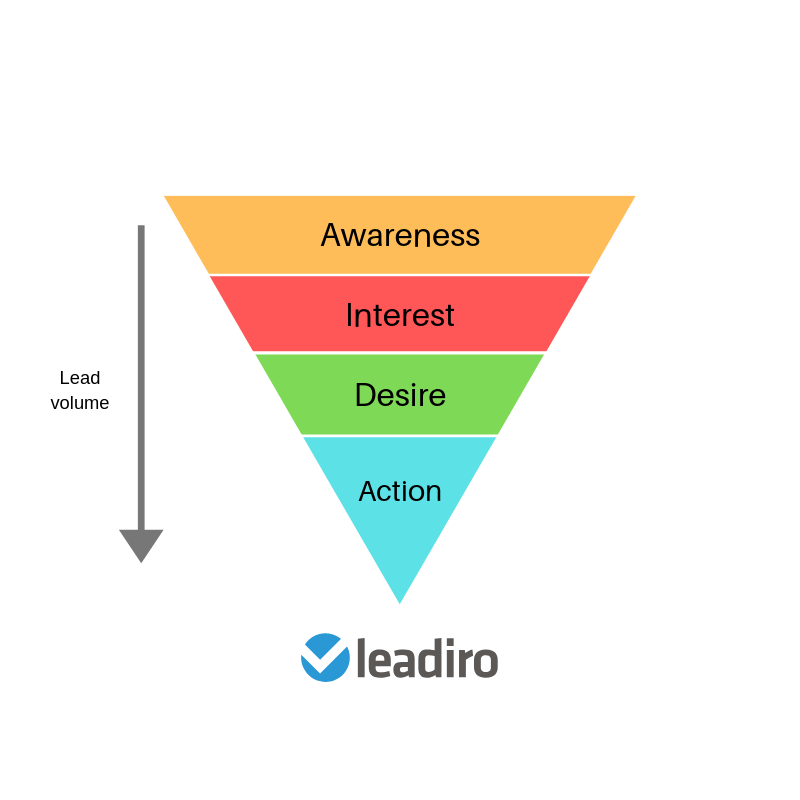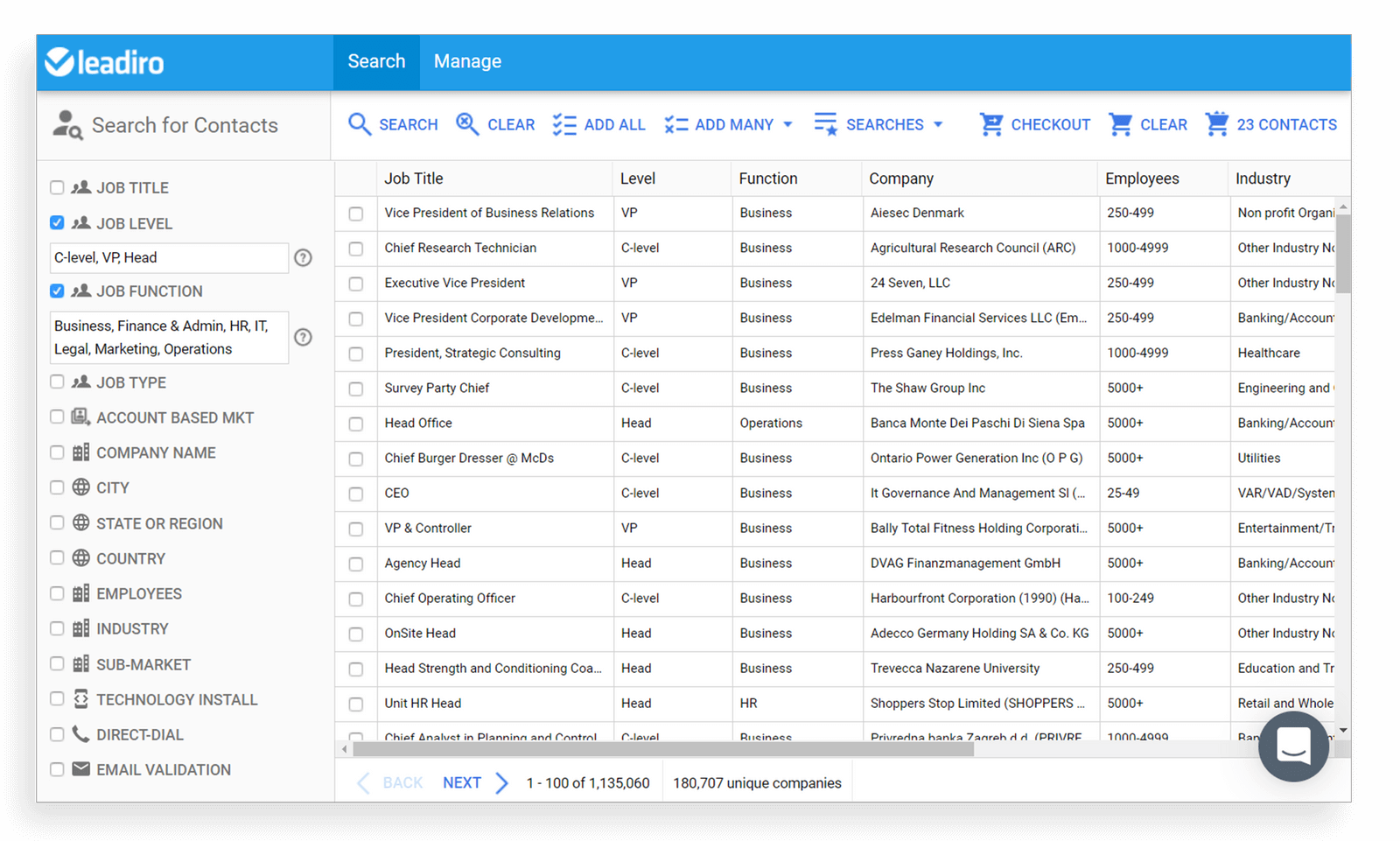
Your sales funnel is the journey that every single customer goes through.
Even if you haven’t consciously created one, you need to be aware of how it affects your customer journey and impacts your revenue.
In this article, we’re going to show everything you need to know to get started with a sales funnel.
- What is a sales funnel?
- Why do you need one?
- Key steps involved in creating a funnel that converts
- Tools to build and manage your funnel
- How to add more leads to your funnel with DemandScience
Let’s jump in.
What is a Sales Funnel?
So, what is a sales funnel and why should you care about building one?
A sales funnel is the path that your website visitors take when buying your product or signing up to your service.
Your sales funnel includes every step of the buying journey. It starts from the initial cold email you send, or the blog post that someone reads for the first time, up until the moment a customer purchases from you.
Some leads will enter the funnel, and never move to the next stage and never buy from you. Others (usually your ideal customers) will move down the funnel and buy your solution with no friction at all.
Steps in the AIDA Sales Funnel
The traditional sales funnel, often referred to as the AIDA funnel includes four key stages.
The steps are:
- Awareness
- Interest
- Desire
- Action
As you’ll see in the diagram below, you’ll have the most leads at the top of the funnel.
Then, as you get further down leads will drop out of your sales funnel, leaving only the most qualified leads.

So, what do each of those steps mean?
1. Awareness
In this stage, your buyer becomes aware of your solution to their product, or the general category your solution falls into.
2. Interest
Your lead begins to research solutions to their problem and starts looking for a product or service that best suits their needs.
You need to ensure your brand is showing up in the right places at the right time. This could be via content that answers specific questions or showing up on review sites like G2 Crowd or Capterra.
3. Desire
Here, the buyer begins to move towards one solution in particular. If your customer is part of a large company they’ll be working on building buy-in from their team before purchasing.
It’s your job to provide as much value as possible to your lead at this stage and ensure you’re answering all the questions your lead has.
4. Action
Finally, your buyer will take action and make a purchase. In some cases, this stage could begin by the customer scheduling a call with your team a similar pre-purchase action.
The ABM Sales Funnel
For many businesses, Account-Based Marketing (ABM) is a powerful way to engage with leads and close new deals more easily.
When you follow an ABM strategy, the stages of your sales funnel will look a little different.
The steps are as follows:
- Identify
- Expand
- Engage
- Convert

Let’s take a quick look at what these steps mean:
1. Identify
The first stage of your ABM campaign is to identify your target accounts. Here, you identify targets based on your buyer persona. you will be reaching out to.
2. Expand
After you’ve identified your target accounts, you need to expand your contact list within the account.
You should find multiple decision-makers within a company that you can reach out to and engage with, to help your team close the deal.
3. Engage
Once you have identified who you’re going to talk to, it’s time to reach out and engage them. Your goal is to build buy-in from all decision-makers within your target accounts.
4. Convert
Finally, once you’ve engaged with your target accounts, it’s time to convert them into paying customers.
Benefits of Creating a Sales Funnel
Building a sales funnel can be a hassle.
You need to carefully map out the stages of your funnel and your customer journey.
But, it’s worth building one and understanding how your customer journey works.
Why?
Here are 3 key benefits.
1. Convert more leads into sales
79% of marketing leads are never converted into sales.
Once you know your sales funnel and customer journey in detail, you begin to understand where your leads are getting ‘stuck’ or falling out of the funnel.
If you don’t identify the places where you’re losing leads, you’ll always convert at far lower rates than you could be.
2. Nurtured leads spend more than non-nurtured leads
Having an effective sales funnel has direct links to higher revenue. Nurtured leads make 47% larger purchases than non-nurtured leads.
Your sales funnel provides a framework to add value to your lead’s buying cycle. The best sales funnels will include a system to provide valuable content and information to leads to help move them towards a purchase.
When it comes to making a purchase, leads who strongly believe in your solution are more likely to spend more.
3. Improve your lead quality
If your sales team has been struggling to hit quota, then reviewing your sales funnel is a worthwhile activity.
All good sales funnels will involve lead nurturing. Popular lead nurturing methods include creating content, having product demos with customers, or anything else that simplifies the buying decision and reduces objections.
When lead nurturing takes place, sales reps hit quota 9% more often. Well nurtured leads will be better qualified, and easier to sell to.
How to Create a Sales Funnel That Converts
Ready to learn the key steps you need to take to create an effective sales funnel?
In this section, we’ll walk you through the main steps you should take when building an effective sales funnel.
Step 1: Capture Lead Information
The first stage of your sales funnel needs to respond to your lead’s initial awareness.
Often, leads will learn about your solution through a blog post, landing page, or other similar pieces of content that show up in their research.
You’ll need an opt-in to capture details such as your lead’s name, email address, and anything else that will help you nurture them.
Step 2: Start a Nurturing Campaign
Once you’ve captured your lead’s contact details, you can start to nurture them towards purchase.
You can create email nurturing campaigns using email marketing automation tools like MailChimp. Another popular method to engage with leads and build interest in your solution is to host webinars on topics that your ideal customers care about.
The goal of your nurturing campaign is to build as much interest in your solution and show your leads why your solution is the best one for them. You’ll need to agitate their pain points and highlight the benefits of your solution.
Step 3: Converting Leads into Paying Customers
Depending on your business you’ll go about converting customers in different ways.
For many B2B businesses, the best way to convert an engaged lead will be for a sales rep to reach out and talk with them.
At DemandScience, we offer a free consultation with a member of our experienced team to show you our platform and it’s benefits to anyone who is considering signing up.
Depending on your price point then you may rely on different CTAs to encourage people to take that final step and enter their payment details.
There’s no right answer to how you should convert leads into customers. You need to base it on customer research, and experimentation to find what works best for your company.
Using Lead Scoring to Prioritize Sales Efforts
How do you know which leads are ready to buy?
Use lead scoring.
What is it? Like you would expect from the name, lead scoring is the act of assigning a score to leads based on the actions they take.
For example:
- Clicked a link in your nurturing email: +3 points
- Downloaded your eBook: +10 points
- Viewing pricing page: +15 points
- Scheduled a product demo with sales: +25 points
Lead scoring gives your team a way to quickly see how engaged leads are, and if they’re close to being ready to buy.
Many email marketing tools and CRMs will have built-in lead scoring, and it’s a highly effective way to see a snapshot of your lead pipeline health.
Based on the information you have about customers, you can qualify leads in various ways. The popular ways to qualify leads are by classifying them as:
As well as lead scoring, you can use the BANT framework to qualify leads.
What does BANT stand for?
- Budget: Can they afford your solution?
- Authority: Is your lead a key decision-maker?
- Need: Why do they need your solution?
- Timing: When are they willing to purchase?
The BANT lead qualification framework helps you focus on the sales opportunities that are most likely to convert, and gives you a clear overview of your pipeline health.
Key Sales Funnel Metrics to Track
Is your sales funnel working?
The only way to know is by measuring it.
There are several key points in your sales funnel that you should be tracking.
Let’s take a look at what they are:
1. Number of entries
The first clear measure of your funnel’s success is how many people enter it.
A funnel entry is when someone engages with your brand for the first time, and you receive their contact details.
Examples of a funnel entry could include:
- Subscribing to your newsletter
- Entering their email in exchange for an eBook
- Scheduling a product demo
Assuming that your marketing efforts are targeting the right people you should see a steady stream of new entries into your funnel.
Your conversion rate will vary, depending on your call-to-action. For context, the average landing page conversion rate is 2.35%.
If you’re seeing conversion rates higher than that, you’re doing well.
Any lower, and you may want to review your messaging, your call-to-action, as well as consider if you’re targeting the right audience.
2. In-Process Conversion Rates
Seeing a good number of entries to your funnel?
Great.
But the journey doesn’t end there.
Once a lead enters your funnel, you need to make sure it’s easy for them to move down the funnel towards a purchase.
After all, having 10,000 newsletter subscribers but no paying customers won’t help your business.
You should be measuring how many people are moving from one step of your sales funnel to the next.
For example, this could be newsletter subscribers who then go on to schedule a demo with your product team.
If your in-process conversion rate is low, there are a few things you can look at:
- Is your call-to-action clear?
- Are you providing value in your funnel that will be interesting to your prospect?
- Have you agitated their pain points and shown how your solution can help?
You can set up the necessary tracking with tools like Google Analytics, HotJar, and FullStory.
If you’re noticing low conversion rates at certain stages in your sales funnel, then you can make updates and improvements as necessary.
You need leads to easily move down your funnel if you expect to see an ROI on your sales and marketing activities.
3. Funnel Velocity
Another important but often overlooked metric is your funnel velocity. This refers to how long it takes for someone to enter your funnel until the moment they become a paying customer.
For higher-priced solutions, you can expect the funnel velocity to be slower than it is for lower-cost products, but you’ll soon be able to establish a benchmark for your business.
You should measure funnel velocity to ensure that there are no points in the funnel that take an unnecessarily long time for leads to move through.
Tools to Create and Manage Your Sales Funnel
When you’re building your sales funnel you’ll need tools to help you.
Let’s take a look at some of the best tools for the job:
Create sales funnel diagrams: Smartdraw
Smartdraw is a handy tool to create flowcharts. You can use these to map out your entire sales funnel and how your customers will move through the funnel.
Lead capture tools: Drift
If you want to engage with leads who are visiting your website, Drift is a great way to do it. You can set up automated campaigns and score leads based on the questions they ask your team, or how often they visit certain pages on your site.
Manage email nurturing campaigns: MailChimp
MailChimp is the most well-known email marketing tool. It’s free to get started with and you can create automated campaigns, ideal for lead nurturing.
Once you’ve set up your campaigns, you can sit back and let your lead nurturing campaign to the heavy lifting.
Drip
Drip is a good alternative to MailChimp that includes powerful features to help you create automated sequences that trigger based on custom events.
Drip has built-in lead scoring that you can link to your website, and it even lets you embed email opt-ins onto your website. It’s a little more expensive than MailChimp but the extra feature can come in handy.
Using DemandScience to Improve Your Funnel
One of the first problems most teams face after creating a sales funnel is getting new leads into it.
If you want to improve your sales funnel and get more leads, DemandScience can help.

With DemandScience you can access accurate B2B data that will help you build a list of qualified prospects who match your ideal customer profile.
You can search for leads by criteria such as job titles, industries, tech stack, as well as other firmographic and demographic information.
Rather than only relying on inbound traffic to grow your lead pipeline, DemandScience enables you to pursue an outbound strategy.

Once you create your lead lists, you can send targeted cold email campaigns, which are a great way to reach out to leads.
Whether you’re a growing startup finding product-market fit, or an established enterprise starting a new ABM campaign, DemandScience can help.
Recap: How to Create a Winning Sales Funnel
Now you know what a sales funnel is, the different types of funnel, and the key steps involved in creating a sales funnel that converts, it’s time for you to start creating yours.
The tools we’ve mentioned should help you set up a funnel with a relatively low investment of money and time. However, you shouldn’t rush the process as you want to ensure it matches your business goals and offers as much value as possible to your leads.
When your funnel is created and ready to go, you can use DemandScience to build high-quality lead lists to power your sales and ABM campaigns.










